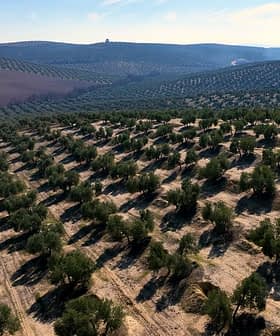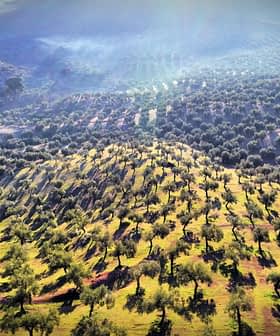Global Olive Oil Production Will Reach 4.4M Tons by 2050, Expert Projects
Intensive groves will outnumber traditional farms thirty years from now, and the number of olive oil-producing countries will rise to 80, says Juan Vilar.
For nearly two decades, Juan Vilar has studied the evolution of global olive oil production. His latest project has involved collecting data from all 66 olive oil-producing countries and making projections into the sector’s future.
The founder and CEO of Juan Vilar Strategic Consultants and professor at the University of Jaén told Olive Oil Times that he expects a steady transition from traditional groves to high-density and super-high-density (also known as intensive and super-intensive) groves, especially as olive growing expands northward.
Modern olive groves would be responsible for producing 77 percent of the total of the 4.4 million stable tons that will be produced (by 2050).
“The trend is that the area ofolive groves with a high slope and moderate slope in dry land is reduced and the area ofmodern olive groves increases, especially the modern olive grove in the crown and irrigated hedges,” he said.
“It is expected that the olive grove area will go from 11,594,986 hectares, at present, to 15,259,471 hectares by 2050,” Vilar added. “That is, in 30 years, the projection of the olive grove area is expected to increase by 32 percent compared with 2021.”
See Also:5.5 Million Hectares of Traditional Olive Groves at Risk of Abandonment“In the year 2041, the world’s olive grove surface area will be 14.1 million hectares, of which 39 percent is traditional olive groves, compared to 7.1 million in 1991, of which 92 percent were traditional,” he continued. “And it is estimated that by the year 2041, there will be 80 olive oil-producing countries, rising from 26 in 1991.”
“All this is easily projected when you have the trend of the evolution in the composition of the olive grove and typology of the 66 current producing countries over the last 40 years, and the current transformation and plantation data are known,” Vilar said. “The rest is done by mathematical analysis, taking into account the cyclical biases of the market, which also existed previously.”
Based on his projections, Vilar said that climate change will have two profound impacts on the future of olive cultivation.
Future water availability will force producers to become more efficient and responsible in planting and irrigating their groves. Changing weather patterns across the world will also condition how olive oil production evolves in the Mediterranean basin.
“Indeed, climate change will act as a negative catalyst in one area and as a positive impulse in others,” Vilar said. “All this will depend on whether it is a country with a hot and dry climate or a wet and cold climate.”
“We bear in mind that the olive tree is already grown in Canada, Germany and the United Kingdom,” he added. “This was unthinkable 10 years ago. Without a doubt, almost 15 new producing countries will debut in just 20 years.”
Vilar predicts that most new olive groves planted, whether in traditional olive oil-producing countries or new ones, will be high-density and super-high-density, which will result in a massive increase in global olive oil production.
Currently, traditional olive groves account for 68 percent of olive grove surface area and high-density and super-high-density olive groves account for the other 32 percent.

Juan Vilar
However, Vilar believes these figures will more or less have flipped by the mid-point of the century when an estimated 15.3 million hectares of farmland will be dedicated to olive growing.
“Of the total surface area, 40 percent – 5.5 million hectares – would be traditional non-transformable olive groves, which would produce 23 percent of all the oil generated by then on the planet,” he said.
“The remaining 60 percent of surface area, occupied by modern olive groves (mainly in hedges), would be responsible for producing 77 percent of the 4.4 million stable tons that will be produced at that time, with a full nominal capacity of 5.8 million tons, as well as a higher proportion of virgin and extra virgin olive oil,” he added. “There will be a greater varietal specialization.”
Currently, global olive oil production is about 3.12 million tons each year, with the highest total of 3.38 million tons produced in the 2017/18 crop year.
Production will steadily increase because most of the olive groves in the 14 new olive oil-producing countries are expected to be planted in high-density or super-high-density. Many traditional olive oil producers will also transition to higher-density plantations.
See Also:Intensive Olive Farms Contribute to Desertification in Spain, Experts Warn“Some countries that will experience a shift from traditional olive groves to a higher percentage of intensive olive groves and hedgerows will be Spain, Greece, Italy, Portugal, Tunisia and Turkey,” Vilar said.
Despite this transition, the concentration of olive groves is expected to be a bit more spread out in the future. However, Vilar said that traditional olive oil-producing countries do not need to worry about being outcompeted by newcomers anytime soon.
Currently, 87 percent of the world’s olive groves are located in nine Mediterranean countries. However, this figure will decrease as climate change causes new areas to become increasingly apt for olive growing and others to become less so.
“Let us bear in mind that a 32-percent positive evolution of the surface area is expected in the next 30 years,” Vilar said.
“Without a doubt, in those 80 producing countries, only 10 will continue to hold more than 70 percent of the total surface,” he concluded. “The incorporation of new producers will boost consumption out of familiarity, but in no case will they pose a threat to those olive groves.”








